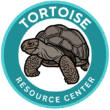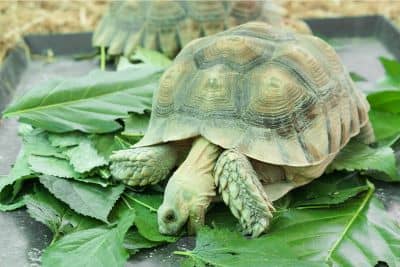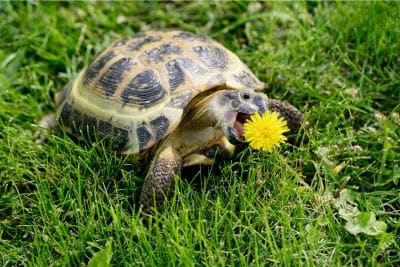One of the most common questions we get at The Tortoise Resource Center is “How much calcium does a baby sulcata need” I understand the concern, as calcium is a critical nutrient for a baby grassland tortoise, but it’s almost impossible to know if your sulcata is getting enough on any given day.
Baby sulcata tortoises are among the fastest-growing reptiles you’ll encounter, and this rapid development comes with some very specific nutritional requirements. If you’re new to keeping sulcatas, you’ve probably already discovered that these little powerhouses have big appetites and even bigger calcium needs.
Getting calcium supplementation right for baby sulcatas isn’t just important—it’s absolutely critical. Make a mistake here, and you could be looking at serious health problems down the road, including metabolic bone disease and shell deformities that can’t be reversed.
The good news? Once you understand the basics, providing proper calcium supplementation becomes a straightforward part of your daily care routine.
Why Baby Sulcatas Need So Much Calcium
Baby sulcatas grow at an absolutely incredible rate. In their first year alone, a healthy hatchling can grow from the size of a ping-pong ball to several inches across. This isn’t just surface growth—their bones are developing, their shells are hardening and expanding, and their internal skeletal structure is forming. That requires a lot of calcium, since bones and shells are made up of primarily calcium.
And not only that, this development requires massive amounts of bioavailable calcium. Unlike adult tortoises, whose growth has slowed dramatically, baby sulcatas are essentially calcium-burning machines for their first few years of life.
Here’s the thing though: it’s not just about the amount of calcium you provide. The ratio of calcium to phosphorus in their diet is what really matters. The ideal ratio is 2:1 to 3:1 (calcium to phosphorus). This is because phosphorus can actually block calcium absorption when it’s present in excessive amounts in a diet. This is why it’s so important to provide a tortoise diet designed specifically for baby grassland tortoises.
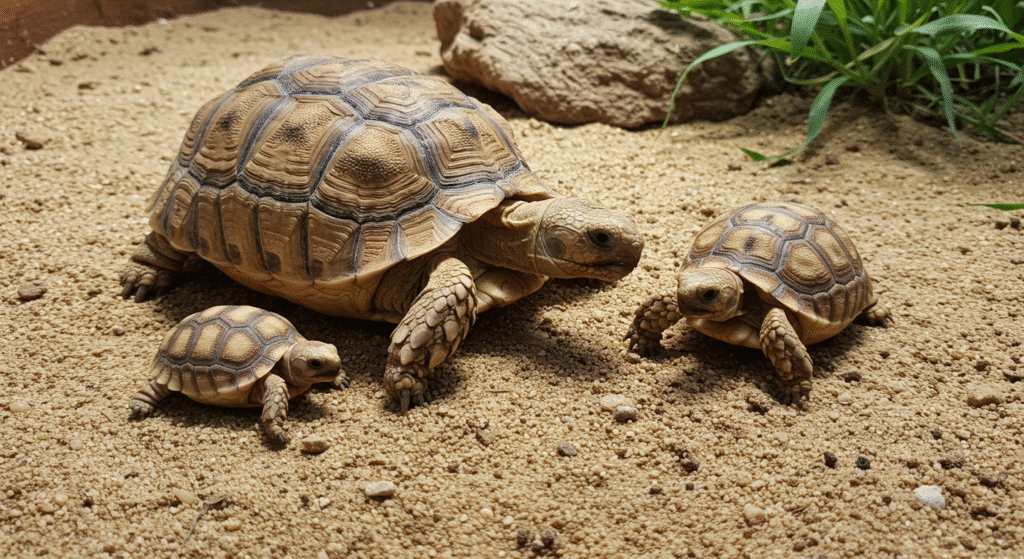
Daily Calcium Requirements by Age
Hatchlings to 1 Year: Baby sulcatas under one year need calcium supplementation with every single feeding. For most keepers, this means daily calcium dusting of their food items. You should be lightly dusting their greens and vegetables 5-6 times per week minimum.
1-3 Years: As your sulcata enters its juvenile phase, you can reduce supplementation slightly to 4-5 times per week. However, don’t get complacent here—these tortoises are still growing rapidly and need consistent calcium intake.
Adults (3+ Years): Adult sulcatas require less frequent supplementation, typically 2-3 times per week, since their growth rate slows considerably.
The key word here is “lightly.” You want a fine dusting that covers the food without creating a thick, chalky coating. Too much calcium powder can make food unpalatable, and your tortoise may refuse to eat altogether. It’s also important to find a supplement that your tortoise enjoys. All animals have different tastes, so try a few different options to see what your little friend likes.
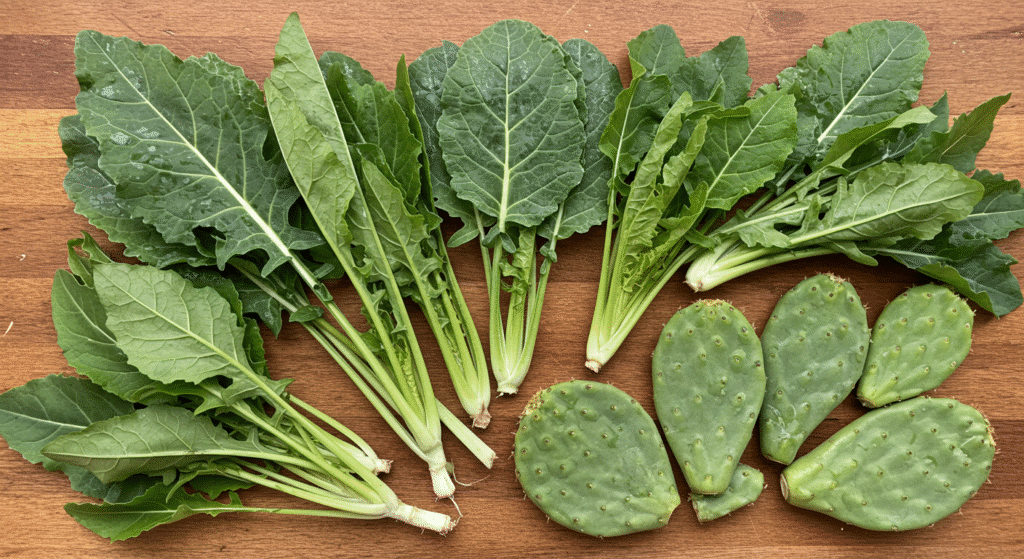
Natural Calcium Sources That Actually Work
While supplementation is essential, incorporating high-calcium foods into your baby sulcata’s diet provides additional nutritional benefits and helps create a more balanced approach to calcium intake.
Dandelion Greens: These common “weeds” are calcium powerhouses, containing about 187mg of calcium per 100g of fresh weight. They’re also packed with other beneficial vitamins and minerals. If you have a yard, you probably have free sulcata food growing right outside your door.
Collard Greens: With approximately 232mg of calcium per 100g, collard greens should be a staple in any sulcata’s diet. They’re readily available at most grocery stores and are generally well-accepted by tortoises.
Mustard Greens: Providing around 103mg of calcium per 100g, mustard greens add valuable variety to your tortoise’s diet while contributing to their calcium intake.
Turnip Greens: These contain approximately 190mg of calcium per 100g and offer excellent nutritional value beyond just calcium content.
Prickly Pear Cactus: This is particularly valuable because it’s part of the sulcata’s natural diet in the wild. The pads provide both calcium and hydration, making them an ideal food choice when available.
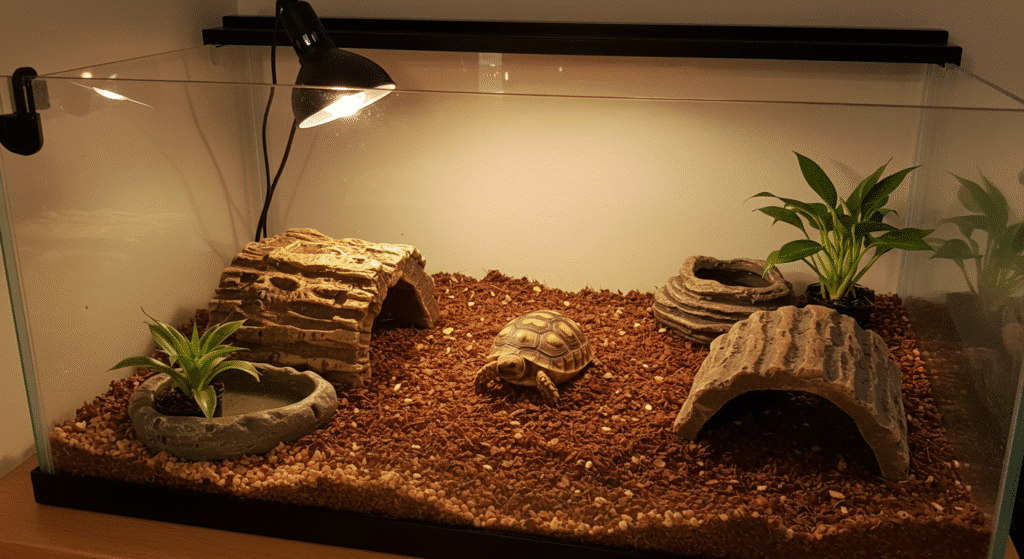
The UVB Connection You Can’t Ignore
Here’s something that catches many new keepers off guard: calcium supplementation alone won’t prevent metabolic bone disease. Your baby sulcata needs proper UVB lighting to synthesize vitamin D3, which is essential for calcium absorption in the digestive tract.
Without adequate UVB exposure, even perfectly supplemented tortoises can develop serious health problems.
Baby sulcatas need 10-12 hours of high-quality UVB lighting daily. The UVB source should be positioned 12-18 inches from the basking area, and bulbs should be replaced every 6-12 months depending on the manufacturer’s recommendations.
Warning Signs of Calcium Problems
Calcium Deficiency Signs:
- Soft or flexible areas of the shell that should be firm
- Pyramiding (scutes growing upward in pyramid shapes rather than remaining relatively flat)
- Lethargy and reluctance to move normally
- Difficulty supporting their own body weight
- Deformed limbs or irregular shell growth
Calcium Overdose Signs:
- Kidney problems
- Chronic constipation
- Signs of anemia (from interference with iron absorption)
- Refusal to eat (from unpalatable over-supplementation)
Common Mistakes to Avoid
Inconsistent supplementation: Skipping days or weeks and then trying to “make up for it” with heavy supplementation doesn’t work and can cause problems.
Ignoring calcium-to-phosphorus ratios: Feeding high-phosphorus foods without considering the overall dietary balance can negate your supplementation efforts.
Poor storage of supplements: Calcium supplements can lose potency when exposed to moisture and heat. Store them in cool, dry places.
Are You Starving Your Tortoise?
Save 10% on premium tortoise food and supplements from Tortoise Resource Center on Amazon now using code BUYNOWGET10
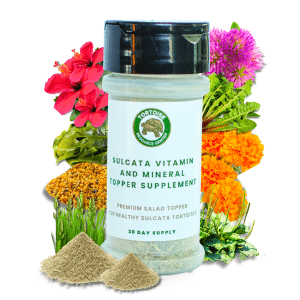
Sulcata Vitamin & Mineral Topper Supplement
30-Day Supply | 2 oz (56 g)
$24.99
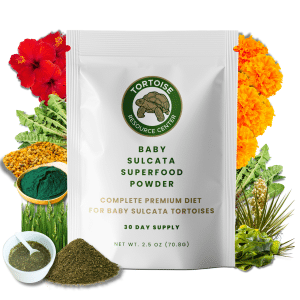
Baby Sulcata Tortoise Superfood Powder
30-Day Supply | 2.5 oz (70.8 g) Bag
$24.99
When to Seek Professional Help
You should consult with a reptile-experienced veterinarian if you notice any signs of calcium deficiency or if you’re unsure about your supplementation approach. Regular check-ups during the first year are invaluable for monitoring growth and development.
Keep detailed records of your tortoise’s diet, supplementation schedule, and growth progress. This information will be extremely helpful for your veterinarian and for identifying patterns or potential issues.

The Bottom Line
Proper calcium supplementation for baby sulcatas requires consistency, attention to ratios, and a balanced approach that includes both supplementation and natural calcium sources. The goal is steady, appropriate calcium intake that supports healthy growth without creating mineral imbalances.
Remember that calcium supplementation is just one piece of the puzzle. Combined with proper UVB lighting, appropriate temperatures, correct humidity levels, and a diet rich in natural calcium sources, thoughtful supplementation helps ensure your baby sulcata develops into a healthy adult.
The investment you make in proper nutrition during these crucial early months will pay dividends for decades to come. Get it right now, and you’ll have a strong, healthy tortoise that can live for 50+ years. Get it wrong, and you may be dealing with expensive and devastation health problems that could have been easily prevented.
Your baby sulcata is counting on you to provide the calcium foundation necessary for a long, healthy life. With the right approach and consistent care, you can give them exactly what they need to thrive. Want to learn more? Download your baby sulcata care bonus pack today to get coupons, a growth tracker and more!
